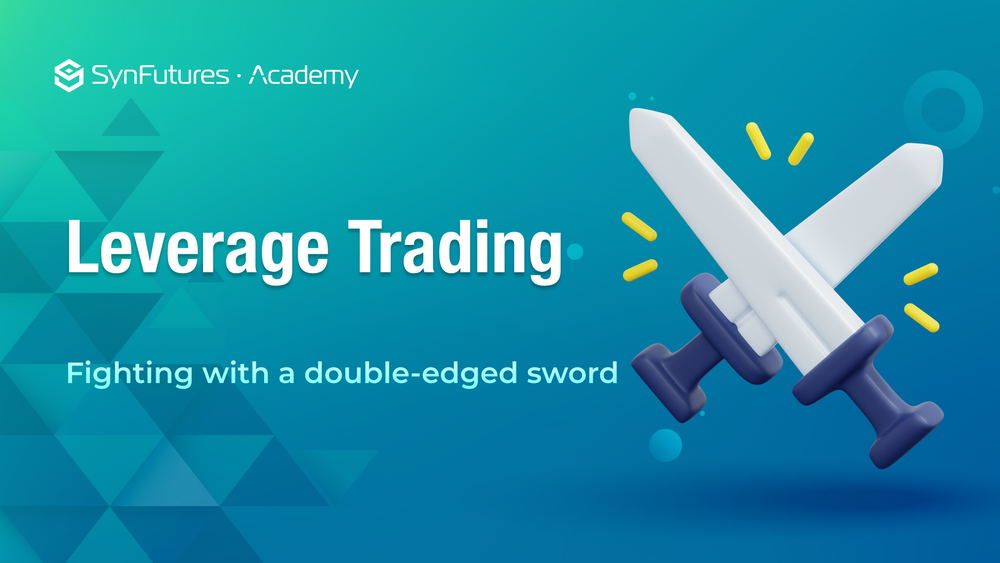Leverage Trading: Fighting with a Double-edged Sword
Overview
Leverage trading refers to using a small amount of capital as collateral to take a much larger trading position in the market. It can vary from a safe 1x to an extreme 100x or even 125x. The primary attraction of this type of trade is that it allows traders to earn high returns by taking high risks. Higher leverage means the potential for bigger profits but also a higher chance of losing the entire capital. This is why leverage trading is often referred to as a double-edged sword and is generally not recommended for beginners just starting their trading career.
This article will go through key details like leverage trading, different terminologies used, and how to manage risks and maximize the benefits. Hopefully, this will help you better understand a crucial part of the derivatives market and decide when and how to trade using leverage.
Important Terms
There are several critical components to a leveraged trade. To become a successful trader, it’s essential to understand what they are and how they interact with each other. Let’s look at a few of them below:
- Margin Amount: Amount deposited by the trader as collateral. The total position allowed is calculated using the margin amount and the leverage the trader chooses to use. Generally, Position size = Margin amount x Leverage chosen.
- Leverage: Leverage is the ratio of your position to margin. If a trader has a $1,000 margin and takes a $10,000 position, the leverage would be 10x. Essentially, Leverage = Position Size/Margin amount. Some commonly used leverage options are 1x, 2x, 5x, 10x, 20x, 50x, and 100x. Lower leverages are safer, while higher leverage could bring more profit. Ultimately, choosing the right leverage is balancing risk to reward.
- Funding Rate: An additional fee that traders must pay when they trade perpetual swaps. Unlike regular futures contracts with expiry dates, perpetual swaps can be held indefinitely. You can learn about them here. This feature also causes the futures contract price to diverge a lot from the underlying asset price. Therefore, the funding rate is used to address that issue and bring the futures contract price close to the spot price of the underlying asset. The fee is usually a small percentage of the total borrowed amount. However, it’s collected at regular intervals, usually 8 hours, but the time varies from exchange to exchange. The longer a trade stays open, the more funding fees must be paid.
- Liquidation price: The price at which the exchange will automatically close the position and deduct the loss from the margin amount. If a trading position goes into loss and causes the collateral to be less than the minimum required margin, liquidation will be triggered. Using higher leverage would bring the liquidation price closer to the entry price and thereby increase the chances of liquidation.
How Leverage Trading Works
As we learned above, when traders enter a leveraged trade, they submit a margin amount to the exchange, which keeps the amount as collateral and allows the trader to take a much larger position. The position size depends on the amount of leverage and the collateral amount. For example, a trader with a $1,000 margin can take a $10,000 position if he/she decides to go with 10x leverage and can even take a $100,000 position with a 100x leverage.
If the trade goes well, the trader exits with a big profit. If the trade goes poorly and hits the liquidation price, the exchange automatically closes the position and deducts the entire loss from the margin amount. In worst-case scenarios, traders lose their entire capital in just one trade.
The chart below provides a rough estimate of the relationship between liquidation and leverage. It shows how many percentages the market needs to move against the trader’s position to reduce the margin amount to zero and trigger liquidation.
It must be noted that in actual trades, the liquidation percentage might be even lower than what is shown in the chart. Because of volatility, most exchanges would close the position before the margin account reaches zero.
As we can see in the image above, the price movement required to cause liquidation keeps going down with increasing leverage. This is bad for traders because even a small price fluctuation against their position could wipe out their capital at high leverage.
Example of a Margin Trade
Let’s understand this further with an example: Say Adam and Ben both have $500, and both believe Bitcoin is about to go higher by 5% in the coming days. Adam puts his $500 in a margin account and enters a 5x leverage trade worth $2,500, while Ben uses his $500 and enters a 50x leverage trade worth $25,000. If Bitcoin goes up by 5%, Adam will gain $125, while Ben will gain $1,250. However, as the chart above shows, Ben’s position will get liquidated if Bitcoin goes down by 2% even once, while Adam’s position will only get liquidated if Bitcoin goes down by 20%.
| Initial Capital | Leverage | Potential Profit | Liquidation level |
ADAM | $500 | 5x | $125 | -20% |
BEN | $500 | 50x | $1,250 | -2% |
So, let’s look at the price charts and see what happens.
As we can see, even though both Adam and Ben were right on their initial assessment, Adam ended up with $125 in profit while Ben ended up with a $500 loss. This chart shows the power and the potential drawbacks of a leverage trade.
Higher leverage is not always bad. Suppose a trader understands the risks and takes the necessary risk management to protect their capital. In that case, leverage trading can be hugely beneficial, as it was to Adam, who made a whopping 25% return on his initial capital in just a few days.
Risk Management
By now, you understand that leverage trading gives you higher returns for higher risks. However, this risk does not have to be unlimited. Traders can follow several good practices to reduce their risk of liquidation. Let us look at some of those below:
- Set take-profits and stop-loss: Before entering any trade, decide on proper stop-loss and take-profit levels. If the market is moving against the position and hits the stop-loss level, then most successful traders would book the loss and protect the remaining capital rather than place hope in a future reversal and profit. Capital protection should always be an essential part of any trading plan. Similarly, if the market is moving in your favor, the position and then book profit at the pre-determined level. Waiting for more profit could turn a profitable trade into a losing one.
- Calculate risk and reward: Once stop-loss and take-profits are decided, calculate the risk-reward ratio of the trade. Risk is the amount of money you are likely to lose if the trade hits the stop-loss and the reward is the amount you are likely to gain if the trade hits take-profit. Consider entering a trade only if the reward is more than the risk. Traders often use 3-to-1, 2-to-1, or 1.5-to-1 reward-to-risk ratios. You can choose whatever you feel is suitable for your strategy.
- Don’t gamble: Probably the most common mistake many new traders make. Since exchanges offer up to 100x leverage, several new traders use it as a gambling mechanism to either win big or lose it all. Doing this is a quick way to lose the entire capital. Successful traders don’t gamble; they have strategies and execute them dispassionately.
- Select the proper leverage: Just because an exchange offers 100x leverage doesn’t mean all of it should be used. As we saw earlier, high leverage increases the chances of liquidation and makes the trade vulnerable to volatile price swings. Choose a leverage that can maximize profit while protecting the capital from liquidation.
- Understand the volatility of different assets: Since success in a leveraged trade depends on the underlying asset's price movement, it’s important to understand its volatility. Stocks are less volatile, Bitcoin is more volatile than most stocks, and altcoins are more volatile than Bitcoin. Take the volatility of the asset into account when deciding on leverage, stop-loss, and take-profit levels.
- Determine position size: Most successful traders don’t put their entire capital in a single trade. They calculate the position size of a particular trade by calculating the maximum amount of money they are willing to lose. As a rule of thumb, that’s usually around 2%, but that’s up to individual preference. Using the max risk and stop-loss, we can calculate the position size.
For example: if the capital is $10,000, the max risk per trade is $200. Let’s say the stop-loss for a particular trade is at 3%, so the total position size would be a maxed risk/stop-loss (200/3%), which would be $6,666.66. This way, even if the market moves against the trader’s position and the stop-loss gets hit, the trader will only lose 3% of $6,666 ($200), which would only be a fraction of the total capital. The idea here is to ensure that one bad trade doesn’t end up wiping out the entire capital.
Conclusion
Leverage can be a powerful tool if used correctly. It can bring enormous profits or wipe out the whole account. Those traders who use leverage cautiously and with precaution could increase their wealth, while those that use it as a gambling instrument are far more likely to lose their capital. Ultimately, like every other tool, its effectiveness will depend on the person who wields it. Hopefully, this article has given you a better idea about leverage trading and will help you become a more effective trader.
Discover SynFutures' Crypto Derivatives products: www.synfutures.com/.
Disclaimer: SynFutures Academy does not guarantee the reliability of the site content and shall not be held liable for any errors, omissions, or inaccuracies. The opinions and views expressed in any SynFutures Academy article are solely those of the author(s) and do not reflect the opinions of SynFutures. The SynFutures Academy articles are for educational purposes or information only. SynFutures Academy has no relationship to the projects mentioned in the articles, and there is no endorsement for these projects. The information provided on the site does not constitute an endorsement of any of the products and services discussed or investment, financial, or trading advice. A qualified professional should be consulted prior to making financial decisions.




